| Independence Day | |
|---|---|
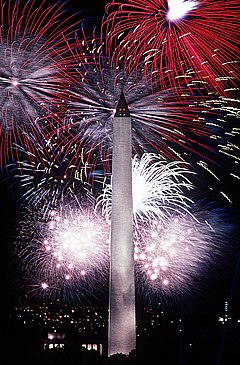 Fireworks displays, such as these over the Washington Monument in 1986, take place annually across the United States on July 4th, known as Independence Day. Fireworks displays, such as these over the Washington Monument in 1986, take place annually across the United States on July 4th, known as Independence Day. | |
| Also called | Fourth of July |
| Observed by | United States |
| Type | National day |
| Significance | The day in 1776 that the Declaration of Independence was adopted by the Second Continental Congress in Philadelphia |
| Celebrations | Fireworks, family reunions, concerts, barbecues, picnics, parades, baseball games |
| Date | July 4 |
| Frequency | Annual |
Independence Day, known colloquially as the Fourth of July, is a federal holiday in the United States which commemorates the ratification of the Declaration of Independence by the Second Continental Congress on July 4, 1776, establishing the United States of America.
The Founding Father delegates of the Second Continental Congress declared that the Thirteen Colonies were no longer subject (and subordinate) to the monarch of Britain, King George III, and were now united, free, and independent states. The Congress voted to approve independence by passing the Lee Resolution on July 2 and adopted the Declaration of Independence two days later, on July 4.
Independence Day is commonly associated with fireworks, parades, barbecues, carnivals, fairs, picnics, concerts, baseball games, family reunions, political speeches, and ceremonies, in addition to various other public and private events celebrating the history, government, and traditions of the United States. Independence Day is the national day of the United States.
Background
During the American Revolution, the legal separation of the thirteen colonies from Great Britain in 1776 actually occurred on July 2, when the Second Continental Congress voted to approve a resolution of independence that had been proposed in June by Richard Henry Lee of Virginia declaring the United States independent from Great Britain's rule. After voting for independence, Congress turned its attention to the Declaration of Independence, a statement explaining this decision, which had been prepared by the Committee of Five, which asked Thomas Jefferson to author its first draft.
While Jefferson consulted extensively with the other four members of the Committee of Five, he largely wrote the Declaration of Independence in isolation over 17 days between June 11, 1776, and June 28, 1776, from the second floor he was renting in a three-story private home at 700 Market Street in Philadelphia, now known as the Declaration House, and within walking distance of Independence Hall.
Congress debated and revised the wording of the Declaration, removing Jefferson's vigorous denunciation of King George III for importing the slave trade, finally approving it two days later on July 4. A day earlier, John Adams wrote to his wife Abigail:
The second day of July 1776, will be the most memorable epoch in the history of America. I am apt to believe that it will be celebrated by succeeding generations as the great anniversary festival. It ought to be commemorated as the day of deliverance, by solemn acts of devotion to God Almighty. It ought to be solemnized with pomp and parade, with shows, games, sports, guns, bells, bonfires, and illuminations, from one end of this continent to the other, from this time forward forever more.
Adams's prediction was off by two days. From the outset, Americans celebrated independence on July 4, the date shown on the much-publicized Declaration of Independence, rather than on July 2, the date the resolution of independence was approved in a closed session of Congress.
Historians have long disputed whether members of Congress signed the Declaration of Independence on July 4, even though Thomas Jefferson, John Adams, and Benjamin Franklin all later wrote that they had signed it on that day. Most historians have concluded that the Declaration was signed nearly a month after its adoption, on August 2, 1776, and not on July 4 as is commonly believed.
By remarkable coincidence, Thomas Jefferson and John Adams, the only two signatories of the Declaration of Independence later to serve as presidents of the United States, both died on the same day: July 4, 1826, which was the 50th anniversary of the Declaration. Although not a signatory of the Declaration of Independence, James Monroe, another Founding Father who was elected president, also died on July 4, 1831, making him the third President who died on the anniversary of independence. The only U.S. president to have been born on Independence Day was Calvin Coolidge, who was born on July 4, 1872.
Observance
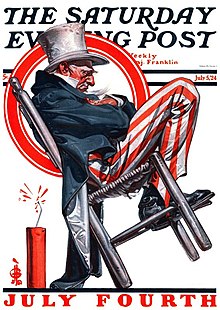

- In 1777, thirteen gunshots were fired in salute, once at morning and once again as evening fell, on July 4 in Bristol, Rhode Island. An article in the July 18, 1777, issue of The Virginia Gazette noted a celebration in Philadelphia in a manner a modern American would find familiar: an official dinner for the Continental Congress, toasts, 13-gun salutes, speeches, prayers, music, parades, troop reviews, and fireworks. Ships in port were decked with red, white, and blue bunting.
- In 1778, from his headquarters at Ross Hall, near New Brunswick, New Jersey, General George Washington marked July 4 with a double ration of rum for his soldiers and an artillery salute (feu de joie). Across the Atlantic Ocean, ambassadors John Adams and Benjamin Franklin held a dinner for their fellow Americans in Paris, France.
- In 1779, July 4 fell on a Sunday. The holiday was celebrated on Monday, July 5.
- In 1781, the Massachusetts General Court became the first state legislature to recognize July 4 as a state celebration.
- In 1783, Salem, North Carolina, held a celebration with a challenging music program assembled by Johann Friedrich Peter entitled The Psalm of Joy. The town claims it to be the first public July 4 event, as it was carefully documented by the Moravian Church, and there are no government records of any earlier celebrations.
- In 1870, the U.S. Congress made Independence Day an unpaid holiday for federal employees.
- In 1938, Congress changed Independence Day to a paid federal holiday.
Customs
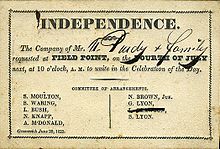
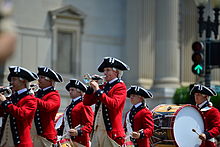
Independence Day is a national holiday marked by patriotic displays. Per 5 U.S.C. § 6103, Independence Day is a federal holiday, so all non-essential federal institutions (such as the postal service and federal courts) are closed on that day. While the legal holiday remains on July 4, if that date happens to be on a Saturday or Sunday, then federal government employees will instead take the day off on the adjacent Friday or Monday, respectively. Other non-essential that are non-government related may also be closed that day.
Families often celebrate Independence Day by hosting or attending a picnic or barbecue; many take advantage of the day off and, in some years, a long weekend to gather with family members or friends. Parades are often attended in many towns and cities, some being hours-long, with many floats and participants. Parades are often held in the mid-late morning (before get-togethers), with longer spectacles sometimes extending into the early afternoon. Fireworks displays typically occur in the evening, at such places as parks, harbors, off of boats, sporting venues, fairgrounds, public shorelines, or town squares. Decorations (e.g., streamers, balloons, and clothing) are generally colored red, white, and blue, the colors of the American flag, and many homes and businesses will decorate their properties with miniature American flags.
The night before the Fourth was once the focal point of celebrations, marked by raucous gatherings, often incorporating bonfires as their highlight. In New England, towns competed to build towering pyramids, assembled from barrels and casks. They were lit at nightfall to usher in the celebration. The highest ever were in Salem, Massachusetts, with pyramids composed of as many as forty tiers of barrels. These made some of the tallest bonfires ever recorded. The custom flourished in the 19th and 20th centuries and is still practiced in some New England and northeastern towns.
Independence Day fireworks are often accompanied by patriotic songs, such as "The Star-Spangled Banner" (the American national anthem); "Columbia, the Gem of the Ocean"; "God Bless America"; "America the Beautiful"; "My Country, 'Tis of Thee"; "This Land Is Your Land"; "Stars and Stripes Forever"; "Yankee Doodle"; "God Bless the U.S.A." and "Dixie" (in southern states); "Lift Every Voice and Sing"; and occasionally (but has nominally fallen out of favor), "Hail Columbia". Some of the lyrics recall images of the Revolutionary War or the War of 1812.
Firework shows are held in many states, and many fireworks are sold for personal use or as an alternative to a public show. Safety concerns have led some states to ban fireworks or limit the sizes and types allowed. In addition, local and regional conditions may dictate whether the sale or use of fireworks in an area will be allowed; for example, the global supply chain crisis following the COVID-19 pandemic forced cancellations of shows. Some local or regional firework sales are limited or prohibited because of dry weather or other specific concerns. On these occasions the public may be prohibited from purchasing or discharging fireworks, but professional displays (such as those at sports events) may still take place.
A salute of one gun for each state in the United States, called a "salute to the union", is fired on Independence Day at noon by any capable military base.
New York City has the largest fireworks display in the country sponsored by Macy's, with more than 22 tons of pyrotechnics exploded in 2009. It generally holds displays in the East River. Other major displays are in Seattle on Lake Union; in San Diego over Mission Bay; in Boston on the Charles River; in Philadelphia over the Philadelphia Museum of Art; in San Francisco over the San Francisco Bay; and on the National Mall in Washington, D.C.
During the annual Windsor–Detroit International Freedom Festival, Detroit, Michigan, hosts one of the largest fireworks displays in North America, over the Detroit River, to celebrate Independence Day in conjunction with Windsor, Ontario's celebration of Canada Day.
The first week of July is typically one of the busiest United States travel periods of the year, as many people use what is often a three-day holiday weekend for extended vacation trips.
Celebration gallery
- Patriotic trailer shown in theaters celebrating July 4, 1940
-
 Fireworks over the National Mall in Washington, D.C., every July 4 are preceded by a concert known as A Capitol Fourth, which takes place outside the U.S. Capitol and is televised on the American public television network PBS.
Fireworks over the National Mall in Washington, D.C., every July 4 are preceded by a concert known as A Capitol Fourth, which takes place outside the U.S. Capitol and is televised on the American public television network PBS.
-
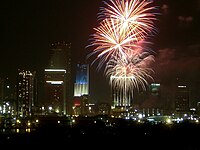 In addition to a fireworks show, Miami, Florida, lights one of its tallest buildings with the patriotic red, white and blue color scheme on Independence Day.
In addition to a fireworks show, Miami, Florida, lights one of its tallest buildings with the patriotic red, white and blue color scheme on Independence Day.
-
New York City's fireworks display, shown above over the East Village, is sponsored by Macy's and is the largest in the country.
-
 Towns of all sizes hold celebrations. Shown here is a fireworks display in America's most eastern town, Lubec, Maine, population 1,300. Canada is across the channel to the right.
Towns of all sizes hold celebrations. Shown here is a fireworks display in America's most eastern town, Lubec, Maine, population 1,300. Canada is across the channel to the right.
-
 A festively decorated Independence Day cake
A festively decorated Independence Day cake
-
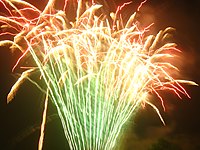 Fireworks in Narberth, Pennsylvania.
Fireworks in Narberth, Pennsylvania.
-
 Neighborhood parade in Denver, Colorado, 2009
Neighborhood parade in Denver, Colorado, 2009
-
 4th of July Parade in Chico, California, 2024
4th of July Parade in Chico, California, 2024
Notable celebrations

- Held since 1785, the Bristol Fourth of July Parade in Bristol, Rhode Island, is the oldest continuous Independence Day celebration in the United States.
- Since 1868, Seward, Nebraska, has held a celebration on the same town square. In 1979 Seward was designated "America's Official Fourth of July City-Small Town USA" by resolution of Congress. Seward has also been proclaimed "Nebraska's Official Fourth of July City" by Governor J. James Exon in proclamation. Seward is a town of 6,000 but swells to 40,000+ during the July 4 celebrations.
- Since 1912, the Rebild Society, a Danish-American friendship organization, has held a July 4 weekend festival that serves as a homecoming for Danish-Americans in the Rebild Hills of Denmark.
- Since 1959, the International Freedom Festival is jointly held in Detroit, Michigan, and Windsor, Ontario, during the last week of June each year as a mutual celebration of Independence Day and Canada Day (July 1). It culminates in a large fireworks display over the Detroit River.
- The famous Macy's 4th of July Fireworks display usually held over the East River in New York City has been televised nationwide on NBC, and locally on WNBC-TV since 1976. In 2009, the fireworks display was returned to the Hudson River for the first time since 2000 to commemorate the 400th anniversary of Henry Hudson's exploration of that river.
- The Boston Pops Orchestra has hosted a music and fireworks show over the Charles River Esplanade called the "Boston Pops Fireworks Spectacular" annually since 1974. Cannons are traditionally fired during the 1812 Overture. The event was broadcast nationally from 1991 until 2002 on A&E, and since 2002 by CBS and its Boston station WBZ-TV. WBZ/1030 and WBZ-TV broadcast the entire event locally, and from 2002 through 2012, CBS broadcast the final hour of the concert nationally in primetime. The national broadcast was put on hiatus beginning in 2013, which Pops executive producer David G. Mugar believed was the result of decreasing viewership caused by NBC's encore presentation of the Macy's fireworks. The national broadcast was revived for 2016, and expanded to two hours. In 2017, Bloomberg Television took over coverage duty, with WHDH carrying local coverage beginning in 2018.
- On the Capitol lawn in Washington, D.C., A Capitol Fourth, a free concert broadcast live by PBS, NPR and the American Forces Network, precedes the fireworks and attracts over half a million people annually.
Other countries
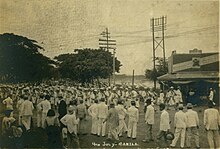
The Philippines celebrates July 4 as its Republic Day to commemorate the day in 1946 when it ceased to be a U.S. territory and the United States officially recognized Philippine Independence. July 4 was intentionally chosen by the United States because it corresponds to its Independence Day, and this day was observed in the Philippines as Independence Day until 1962. In 1964, the name of the July 4 holiday was changed to Republic Day.
Rebild National Park in Denmark is said to hold the largest July 4 celebrations outside of the United States.
While not an Independence Day celebration by any means, the city of Trois-Rivières, Quebec, Canada celebrates its founding every July 4, having been founded on July 4, 1634. Trois-Rivières was also the site of the final battle of the American Revolutionary War that was fought on Quebec soil in June 1776, the Battle of Trois-Rivières, which was also a part of the Continental Army's failed American Invasion of Quebec. Following a defeat at the hands of the British, the Continental Army retreated to Fort Saint-Jean in Saint-Jean-sur-Richelieu, Quebec, and then to Fort Ticonderoga in Ticonderoga, New York, before permanently ceasing their invasion of Quebec in July 1776.
In the English city of Gloucester, its cathedral rang bells in 2019 and 2020 for the anthem "The Star-Spangled Banner" every July 4 for its links to the anthem, commemorating its status as the birthplace of John Stafford Smith, who composed the tune on which the anthem is based.
See also
- Federal holidays in the United States
- Juneteenth
- List of occasions known by their dates
- Born on the Fourth of July (film)
Notes
- "Federal law (5 U.S.C. 6103) establishes the public holidays . . . for Federal employees. Please note that most Federal employees work on a Monday through Friday schedule. For these employees, when a holiday falls on a nonworkday – Saturday or Sunday --the holiday usually is observed on Monday (if the holiday falls on Sunday) or Friday (if the holiday falls on Saturday)." "Federal Holidays". U.S. Office of Personnel Management. Retrieved January 15, 2022.
References
- ^ "What is Independence Day in USA?". Tech Notes. July 2, 2015. Archived from the original on June 22, 2019. Retrieved July 2, 2015.
- ^ Hernández, Javier C. (July 3, 2022). "Amid Ukraine War, Orchestras Rethink '1812 Overture,' a July 4 Rite – Some ensembles have decided not to perform Tchaikovsky's overture, written as commemoration of Russia's defeat of Napoleon's army". The New York Times. Archived from the original on July 4, 2022. Retrieved July 4, 2022.
- "National Days of Countries". Ministry of Foreign Affairs and Trade. New Zealand. Archived from the original on September 4, 2011. Retrieved June 28, 2009.
- Central Intelligence Agency. "National Holiday". The World Factbook. Archived from the original on May 13, 2009. Retrieved June 28, 2009.
- "National Holiday of Member States". United Nations. Archived from the original on July 2, 2012. Retrieved June 28, 2009.
- Becker, p. 3.
- Staff writer (July 1, 1917). "How Declaration of Independence was Drafted" (PDF). The New York Times. Archived (PDF) from the original on July 4, 2020. Retrieved November 20, 2009.
On the following day, when the formal vote of Congress was taken, the resolutions were approved by twelve Colonies–all except New York. The original Colonies, therefore, became the United States of America on July 2, 1776.
- "Visit the Declaration House", National Park Service official website
- "Letter from John Adams to Abigail Adams, 3 July 1776, 'Had a Declaration...'". Adams Family Papers. Massachusetts Historical Society. Archived from the original on August 6, 2011. Retrieved June 28, 2009.
- Maier, Pauline (August 7, 1997). "Making Sense of the Fourth of July". American Heritage. Archived from the original on September 3, 2019. Retrieved June 28, 2009.
- Burnett, Edward Cody (1941). The Continental Congress. New York: W.W. Norton. pp. 191–96. ISBN 978-1104991852.
- Warren, Charles (July 1945). "Fourth of July Myths". William and Mary Quarterly. 3d. 2 (3): 238–272. doi:10.2307/1921451. JSTOR 1921451.
- "Top 5 Myths About the Fourth of July!". History News Network. George Mason University. June 30, 2001. Archived from the original on July 3, 2009. Retrieved June 28, 2009.
- Becker, pp. 184–85.
- For the minority scholarly argument that the Declaration was signed on July 4, see Wilfred J. Ritz, "The Authentication of the Engrossed Declaration of Independence on July 4, 1776" Archived August 18, 2016, at the Wayback Machine, Law and History Review 4, no. 1 (Spring 1986): 179–204.
- Meacham, Jon (2012). Thomas Jefferson: The Art of Power. Random House LLC. p. 496. ISBN 978-0679645368.
- "James Monroe – U.S. Presidents". History.com. Archived from the original on March 23, 2018. Retrieved July 4, 2018.
- Klein, Christopher (July 1, 2015). "8 Famous Figures Born on the Fourth of July". History.com. Archived from the original on July 4, 2018. Retrieved July 4, 2018.
- Heintze, "The First Celebrations".
- ^ Heintze, "A Chronology of Notable Fourth of July Celebration Occurrences".
- Eiland, Murray (2019). "Heraldry on American Patriotic Postcards". The Armiger's News. 41 (1): 1–3 – via academia.edu.
- Graff, Michael (November 2012). "Time Stands Still in Old Salem". Our State. Archived from the original on October 4, 2015. Retrieved July 4, 2018.
- Heintze, "How the Fourth of July was Designated as an 'Official' Holiday".
- Heintze, "Federal Legislation Establishing the Fourth of July Holiday".
- "Federal Holidays". www.opm.gov. U.S. Office of Personnel Management. Archived from the original on November 10, 2021. Retrieved November 13, 2021.
- Hauari, Gabe. "What's open and closed on July 4th? Details on stores, restaurants, Walmart, Costco, Target, more". USA TODAY. Retrieved July 4, 2024.
- "Fourth of July no picnic for the nation's environment". Oak Ridge National Laboratory. July 3, 2003. Retrieved July 4, 2022.
July 4 is by far the most popular day of the year for cookouts, according to a Hearth, Patio & Barbecue Association survey that found that 76 percent of the nation's grill owners use at least one of their grills that day.
- "The Night Before the Fourth". The Atlantic. July 1, 2011. Archived from the original on October 25, 2011. Retrieved November 4, 2011.
- Newell, Shane (July 2, 2018). "Here's how they pick music for a good Fourth of July fireworks show". The Press-Enterprise. Retrieved July 4, 2022.
Jim Souza, president of the Rialto-based Pyro Spectaculars by Souza, said ... 'Everybody wants patriotic music.'
- Gore, Leada (July 3, 2022). "July 4th: Holiday history, more; Why do we celebrate Independence Day with fireworks?". AL.com. Retrieved July 4, 2022.
- Hall, Andy (July 1, 2022). "Which US cities have canceled July 4th fireworks due to fire concerns?". El País. Retrieved July 4, 2022.
- Bryant, Kelly (May 19, 2021). "These Are the States Where Fireworks Are Legal". Reader's Digest.
- "Origin of the 21-Gun Salute". U.S. Army Center of Military History. October 3, 2003. Archived from the original on June 19, 2014. Retrieved July 4, 2014.
- ^ Biggest fireworks show in U.S. lights up sky Archived July 1, 2012, at the Wayback Machine, USA Today, July 2009.
- Nelson, Samanta (July 1, 2016). "10 of the nation's Best 4th of July Firework Shows". USA Today. Archived from the original on July 3, 2018. Retrieved July 3, 2018.
- Newman, Stacy. "Freedom Festival". Encyclopedia of Detroit. Detroit Historical Society. Archived from the original on July 3, 2018. Retrieved July 3, 2018.
- "AAA Chicago Projects Increase in Fourth of July Holiday Travelers" Archived October 9, 2012, at the Wayback Machine, PR Newswire, June 23, 2010
- "Founder of America's Oldest Fourth of July Celebration". First Congregational Church. Archived from the original on March 23, 2014. Retrieved March 23, 2014.
- "History of Seward Nebraska 4th of July". Archived from the original on July 13, 2011.
- "History". Rebild Society. Rebild National Park Society. Archived from the original on July 1, 2009. Retrieved June 30, 2009.
- "2009 Macy's 4th of July Fireworks". Federated Department Stores. April 29, 2009. Archived from the original on July 26, 2011. Retrieved July 4, 2009.
- "Welcome to Boston's 4th of July Celebration". Boston 4 Celebrations Foundation. 2009. Archived from the original on August 22, 2008. Retrieved July 4, 2009.
- James H. Burnett III. Boston gets a nonreality show: CBS broadcasts impossible views of 4th fireworks Archived April 13, 2012, at the Wayback Machine. Boston Globe, July 8, 2011
- Powers, Martine; Moskowitz, Eric (June 15, 2013). "July 4 fireworks gala loses its national pop". The Boston Globe. Archived from the original on June 19, 2013. Retrieved June 16, 2013.
- "With CBS on board again, Keith Lockhart is ready to take over prime time". Boston Herald. July 2016. Archived from the original on July 2, 2016. Retrieved July 2, 2016.
- "7News partners with Bloomberg TV to air 2018 Boston Pops Fireworks Spectacular". WHDH. June 21, 2018. Archived from the original on June 22, 2018. Retrieved June 22, 2018.
- A Capitol Fourth – The Concert Archived February 20, 2014, at the Wayback Machine, PBS, accessed July 12, 2013
- Philippine Republic Day, Official Gazette (Philippines), archived from the original on July 29, 2021, retrieved July 5, 2012
- Lindsey Galloway (July 3, 2012). "Celebrate American independence in Denmark". Archived from the original on November 15, 2014.
- ICI.Radio-Canada.ca, Zone Aucun thème sélectionné- (July 4, 2009). "Bonne fête Trois-Rivières!". Radio-Canada (in Canadian French). Retrieved April 20, 2024.
- "The Battle of Three Rivers (Trois-Rivières)". American Revolutionary War. Retrieved April 20, 2024.
- Troy, Michael. "Episode 095: Battle of Trois-Rivières (Three Rivers)". Retrieved April 20, 2024.
- "Liberty Bells: Gloucester Cathedral Chimes 'Star-Spangled Banner' on July 4th for American NATO Troops". NATO ARRC. Retrieved November 3, 2024.
- Stilliard, Ed (July 1, 2019). "Oh say, can't you hear? How Gloucester will mark American Independence Day on July 4". Gloucestershire Live. Retrieved November 3, 2024.
Further reading
- Becker, Carl L. (1922). The Declaration of Independence: A Study in the History of Political Ideas. New York: Harcourt, Brace. OCLC 60738220. Retrieved July 4, 2020. Republished: The Declaration of Independence: A Study in the History of Political Ideas. New York: Vintage Books. 1958. ISBN 9780394700601. OCLC 2234953.
- Criblez, Adam (2013). Parading Patriotism: Independence Day Celebrations in the Urban Midwest, 1826–1876. DeKalb, IL, US: Northern Illinois University Press. ISBN 9780875806921. OCLC 1127286749.
- Heintze, James R. "Fourth of July Celebrations Database". American University of Washington, D.C. Archived from the original on August 15, 2000. Retrieved February 10, 2015.
- Schauffler, R. H. (1912), Independence Day: its celebration, spirit and significance as related in prose and verse, New York: Moffat, Yard and Company
External links
- Fourth of July Is Independence Day USA.gov, July 4, 2014
- U.S. Independence Day a Civic and Social Event U.S. State Department, June 22, 2010
- Fourth of July Orations Collection at the Division of Special Collections, Archives, and Rare Books, Ellis Library, University of Missouri
| Federal holidays in the United States | |
|---|---|
| Current | |
| Proposed |
|
| Related | |
| United States Declaration of Independence | |||||||||||||||||||||||||||||||||||||||
|---|---|---|---|---|---|---|---|---|---|---|---|---|---|---|---|---|---|---|---|---|---|---|---|---|---|---|---|---|---|---|---|---|---|---|---|---|---|---|---|
| |||||||||||||||||||||||||||||||||||||||
- Independence Day (United States)
- Annual events in the United States
- Federal holidays in the United States
- Fireworks in the United States
- Holidays related to the American Revolution
- Independence days
- July observances
- Public holidays in the United States
- United States flag flying days
- Summer holidays (Northern Hemisphere)